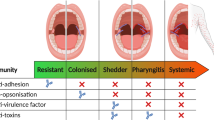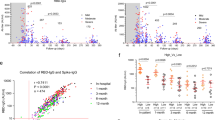Abstract
Superantigens (SAgs) from group A streptococcus (GAS) are potent T cell mitogens, and have been suggested to play a role in severe streptococcal disease. Neutralizing antibodies protect against SAg-mediated disease and their levels should therefore be inversely related to severe streptococcal infection. Neutralizing anti-SAg titers in patients with severe GAS infection and patients without disease were compared in two separate groups. The first group comprised patients with invasive GAS disease from New Zealand European, Maori, and Pacific Island descent. The second group comprised Aboriginal Australian individuals with rheumatic heart disease and/or a past history of acute rheumatic fever. Patients sera were tested for their ability to neutralize T cell mitogenicity of recombinant streptococcal SAgs as a measure of functional SAg-neutralizing antibody concentration. In both studies, no inverse correlation was observed between disease and the level of serum SAg-neutralizing activity. Notably, much higher levels of natural immunity to all streptococcal SAgs were found in New Zealand Maori, New Zealand Pacific Island, and Aboriginal Australian individuals, suggesting a high degree of natural exposure and seroconversion in these groups compared to the New Zealand European cohort. Levels of serum antibodies against SAgs could not be used to predict disease susceptibility in groups with existing high levels of SAg-neutralizing antibodies.


Similar content being viewed by others
References
Ayoub EM, Nelson B, Shulman ST, Barrett DJ, Campbell JD, Armstrong G et al (2003) Group A streptococcal antibodies in subjects with or without rheumatic fever in areas with high or low incidences of rheumatic fever. Clin Diagn Lab Immunol 10(5):886–890
Basma H, Norrby-Teglund A, Guedez Y, McGreer A, Low DE, El-Ahmedy O et al (1999) Risk factors in the pathogenesis of invasive group A streptococcal infections: role of protective humoral immunity. Infect Immun 67(4):1871–1877
Bhatnagar A, Grover A, Ganguly NK (1999) Superantigen-induced T cell responses in acute rheumatic fever and chronic rheumatic heart disease patients. Clin Exp Immunol 116(1):100–106
Bonventre PF, Heeg H, Cullen C, Lian CJ (1993) Toxicity of recombinant toxic shock syndrome toxin 1 and mutant toxins produced by Staphylococcus aureus in a rabbit infection model of toxic shock syndrome. Infect Immun 61(3):793–799
Carapetis JR, Wolff DR, Currie BJ (1996) Acute rheumatic fever and rheumatic heart disease in the Top End of Australia’s Northern Territory. Med J Aust 164:146–149
Eriksson BKG, Andersson J, Holm SE, Norgen M (1999) Invasive group A streptococcal infections: T1M1 isolates expressing pyrogenic exotoxins A and B in combination with selective lack of toxin-neutralizing antibodies are associated with increased risk of streptococcal toxic shock syndrome. J Infect Dis 180:410–418
Finger F, Rossaak M, Umstaetter R, Reulbach U, Pitto R (2004) Skin infections of the limbs of Polynesian children. N Z Med J 117(1192):847–851
Herman A, Kappler JW, Marrack P, Pullen AM (1991) Superantigens: mechanism of T-cell stimulation and role in immune responses. Annu Rev Immunol 9:742–772
Kaplan EL (1991) The resurgence of group A streptococcal infections and their sequelae. Eur J Clin Microbiol Infect Dis 10(2):55–57
Kaul R, McGeer A, Norrby-Teglund A, Kotb M, Schwartz B, O’Rourke K et al (1999) Intravenous immunoglobulin therapy for streptococcal toxic shock syndrome—a comparative observational study. The Canadian Streptococcal Study Group. Clin Infect Dis 28(4):800–807
Miethke T, Wahl C, Heeg K, Echtenacher B, Krammer PH, Wagner H (1992) T cell-mediated lethal shock triggered in mice by the superantigen staphylococcal enterotoxin B: critical role of tumor necrosis factor. J Exp Med 175:91–98
Proft T, Schrage B, Fraser JD (2005) Superantigens—microbial toxins that target the immune system. In: Proft T (ed) Microbial toxins: molecular and cellular biology, horizon bioscience. Wymondham, UK, pp 179–213
Proft T, Sriskandan S, Yang, L, Fraser JD (2003) Superantigens and streptococcal toxic shock syndrome. Emerg Infect Dis 9(10):1211–1218
Proft T, Webb PD, Handley V, Fraser JD (2003) Two novel superantigens found in both group A and group C streptococcus. Infect Immun 71(3):1361–1369
Smoot LM, McCormick JK, Smoot JC, Hoe NP, Strickland I, Cole RL et al (2002) Characterization of two novel pyrogenic toxin superantigens made by an acute rheumatic fever clone of Streptococcus pyogenes associated with multiple disease outbreaks. Infect Immun 70:7095–7104
Sriskandan S, Moyes D, Cohen J (1996) Detection of circulating bacterial superantigen and lymphotoxin-α in patients with streptococcal toxic-shock syndrome. Lancet 348:1315–1316
Stevens DL (2000) Streptococcal toxic shock syndrome associated with necrotizing fasciitis. Annu Rev Med 51:271–288
Taylor FB Jr, Bryant AE, Blick KE, Hack E, Jansen PM, Kosanke SD et al (1999) Staging of the baboon response to group A streptococci administered intramuscularly: a descriptive study of the clinical symptoms and clinical chemical response patterns. Clin Infect Dis 29(1):167–177
Unnikrishnan M, Altmann DM, Proft T, Wahid F, Cohen J, Fraser JD, Sriskandan S (2002) The bacterial superantigen streptococcal mitogenic exotoxin Z is the major immunoactive agent of Streptococcus pyogenes. J Immunol 169:2561–2569
Urdahl KB, Mathews JD, Currie BJ (1996) Anti-streptokinase antibodies and streptokinase resistance in an Aboriginal population in northern Australia. Aust NZ J Med 26:49–53
Acknowledgements
This work was funded by a Marsden Fast Start grant from the Royal Society of New Zealand, a Sir Charles Hercus Research Fellowship from the Health Research Council (HRC) New Zealand (both to T.P.), a grant from the Swedish Society of Medicine (to B.K.G.E.), an Australian National Health and Research Council (NHMRC) project grant (to N.C., No. 216716), by the CRC for Aboriginal and Tropical Health and a grant from the Australian National Heart Foundation (both to Z.H. and B. J. C.). We would like to thank Dr. Bill Abbott and Mrs. Yi Yang for their generous assistance with phlebotomy and Dr. Bill Abbott for his valuable help with statistical analysis.
Author information
Authors and Affiliations
Corresponding author
Rights and permissions
About this article
Cite this article
Yang, L.P.H., Eriksson, B.K.G., Harrington, Z. et al. Variations in the protective immune response against streptococcal superantigens in populations of different ethnicity. Med Microbiol Immunol 195, 37–43 (2006). https://doi.org/10.1007/s00430-005-0245-6
Received:
Published:
Issue Date:
DOI: https://doi.org/10.1007/s00430-005-0245-6




